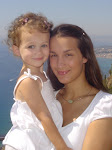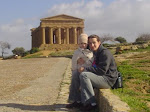
The Polychrome Vase is from the Late Classic Period, AD 700-800, from the forest area of Peten Guatemala. The cylinder shaped vase is made of clay and pigment with male figures painted around the exterior. I assume the vase may be telling a story of a ceremony of an important ritualistic event to please the gods. While researching Mayan pottery I came across a website describing the pottery and the artists, “Maya ceramic artists were highly educated members of the elite. They used slip paint, a mixture of finely ground pigment, clay, and water, to decorate their pottery with images of rituals, myths, geometric motifs, and hieroglyphs. Ceramics were used as tableware, currency, symbols of status, and as offerings to the dead. Clay pots were also made for cooking and storing food.”
After searching the internet for similar Mayan pottery with the figures represented, I found only one that was comparable. Also from the Late Classic Period, the pottery found was said to be representing the Three Noblemen who “offered bread to the gods to ensure success in the planting and harvesting of crops.” The male figures painted on the pottery at the museum did not carry bread, but their bodies are similar in the sitting crossed-leg position, clothing, and head dress, also noted is the profile positioning of the head.
The culture of the Mayas is interesting to say the least. Not only are they known for their pyramids and art, but also for their great achievements: their development of writing and the calendar. The pottery that has survived over the years are small reminders of the Mayan history. We are able to look at the pottery, with a skilled eye and knowledge, and see figures that represent something great and important in their life. A story is told by each piece of pottery that allows us to take a step back in time. The anthropology class sparked my interest of the Mayans but the encounter project gave me the push to act and see the pottery and learn about these hand-made objects.
This post is in response to the Material Culture (Object) encounter assignment.
Canadian Museum of Civilization Corporation. “Civilization.ca.” People of the Jaguar. Mar. 2004. 10 Nov. 2007 <http://www.civilization.ca/civil/maya/mmj01eng.html>.









No comments:
Post a Comment